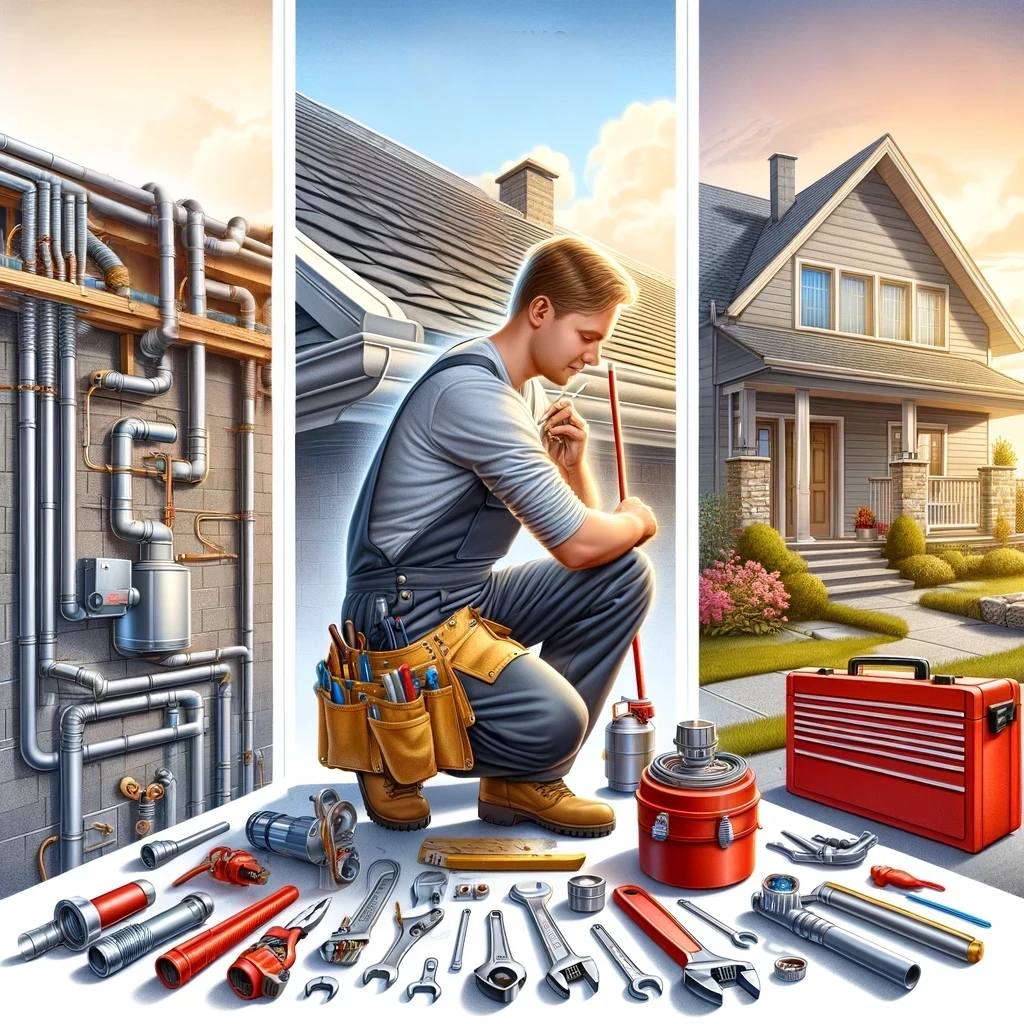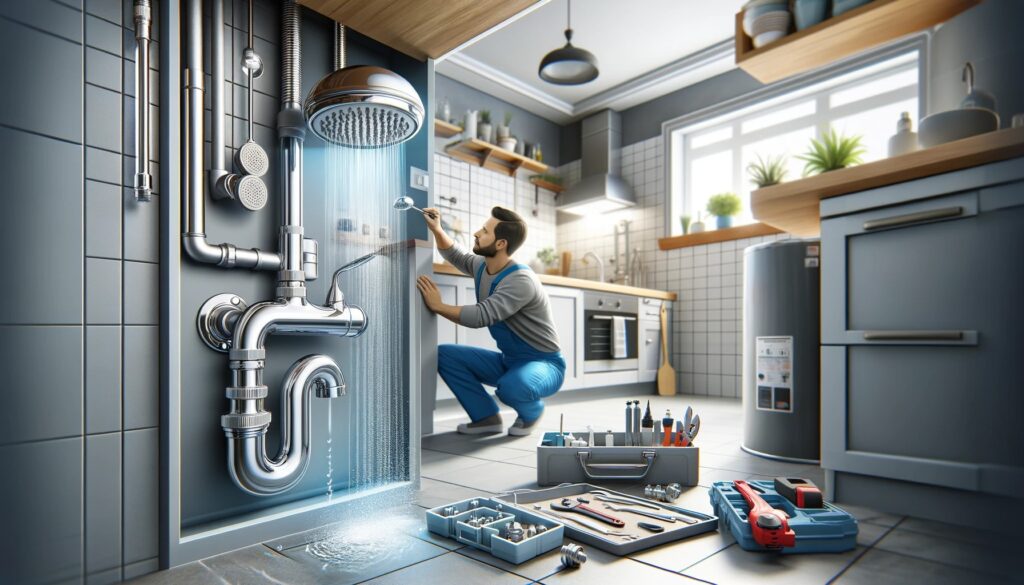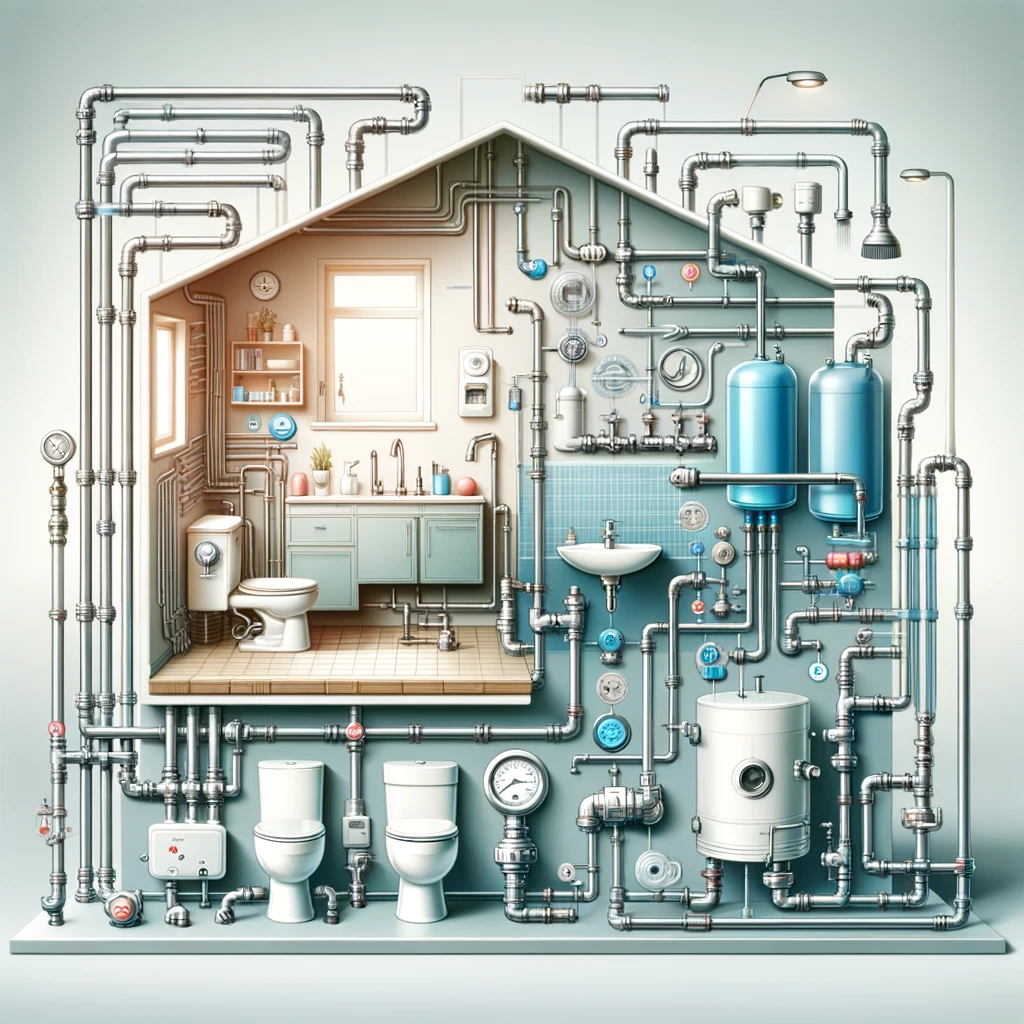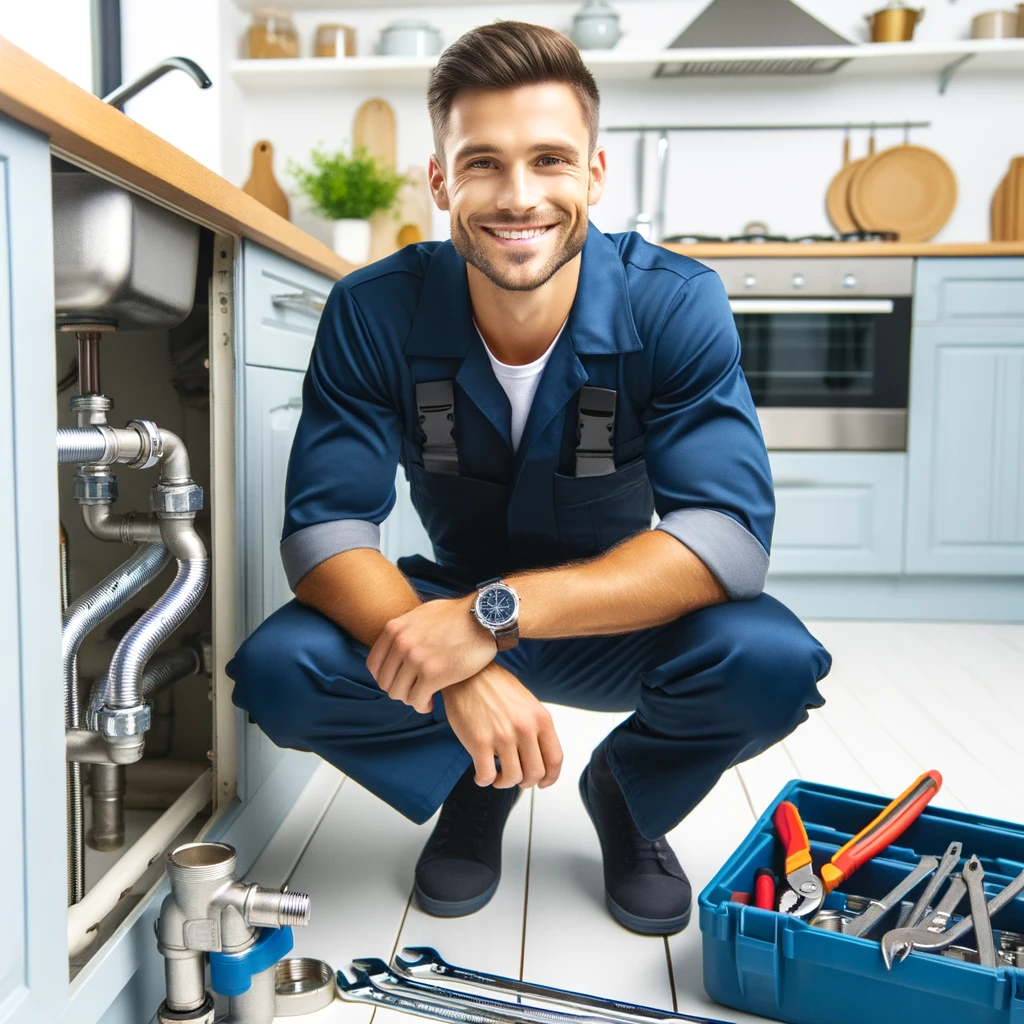The Hidden Lifeline of Your Home: Exploring Types of Plumbing Work
You turn on the faucet, and water flows like it costs nothing. That drags you to the flush, and it happily disappears down with that lovely gurgle. As mentioned earlier, the role of a therapist is not to solve your problem right away but they are there for you like when you make yourself some coffee or take hot shower and steam fills the room. These are all simple actions we know so well, but they depend upon a system, both forgotten about and yet essential; plumbing.
For over 10 years now, I have been part of the plumbing service and it absolutely involves studying every single element that constitutes a material necessity. Between the different categories of pipes and fittings to the process of installation and repair, I have a deeper understanding of how important plumbing is for our houses.
This journey has enabled me to learn that plumbing means more than a leaky fix or unclogging drain; it’s about knowing the mutli-system behind our safe, comfortable and daily life against inconvenience. Utilizing the most up to date plumbing technology and materials to provide an energy efficient, sustainable water system for you, your family and our environment.
I get excited sharing these skills, and this knowledge with you so that you are able to create the home of your dreams knowing how its done. Below, you will find an introduction to the wide world of plumbing in other words — a plumbing 101 along with useful information about different types of plumbing jobs, vital systems and tips on how to make a career in this essential trade work for you.
First of all, let us begin with the basics about their plumbing work.
What is Plumbing Work?
Plumbing work refers to the entire management of water and waste system in residential, commercial or building.B–) This profession is a general trade that presents a variety of work options, including pipe and fixture installation as well as issuing solutions for leaks or blockage in closed conduits.
Plumbing Systems Essential To Everyone
Every home owner should be familiar with the three basic plumbing systems in the house.
- Potable Water Systems: These systems provide you with clean and safe drinking water that flows into your home either from the city water main or a private well. These are the pipes, fittings, and fixtures to your kitchen sink bathroom and other appliances.
- Sanitary Drainage Systems: This refers to the removal of wastewater from the home, including sewage from toilets and graywater (or used water) from sinks, utilities used in food preparation or rain drain. This includes the plumbing pipes, vents and traps used to remove wastewater from various fixtures within a building — whether that be to a municipal sewer system or septic tank.
- Stormwater Drainage Systems: This system is in charge of collecting and draining away rainwater from your home, keeping it free of any flooding that might damage the property. They usually incorporate gutters, downpipes and underground drainage pipes that accumulate stormwater through the vehicle catchment system prior to disbursement into local or designated stormwater systems.
All of these systems are interconnected and have a range of components that all add to the efficiency/successes of your home plumbing. Whether you are embarking on a large remodel or just tackling some minor plumbing problem, it is always better if you have at least a little understanding of these systems so that when its time to seek professional help, not only will be able to make informed decisions but also your plumber would appreciate working with you and take the right repair decision.
Water Supply Plumbing: The Lifeblood of Your Home Hydration
Now can you picture starting your day with no active faucet, a warm shower or hot cup of coffee? The connected series of water supply plumbing are what we all have come to take for granted; the marvel that you will never give a second thought, until it fails. It’s the force behind washing your dishes to even watering your garden.
As a plumber and have seen the secret society that waters your house come from, and how it affects all aspects of everyday living. We also will explore water supply plumbing – the different systems, common tasks and advancements in the field which make this critically important service a reality.

credit: tubomart
Types of Water Supply Systems
The type of system you have is determined by the source of your home’s water supply:
- Municipal Water Systems: The majority of households get their H2O kick from municipal water systems — where water is treated, then piped to form a handy network maintained by your local water authority. The system provides dependable water for all kinds of uses including drinking and cooking, to bathing and irrigation.
- Well Water Systems: If you are residing in rural or semi-urban areas where there is no municipal water supply, then here well water system automatically becomes your main source of household water. Basically, these systems include drilling a well to reach the groundwater depth and then delivering the water to your home.
- Rainwater Harvesting Systems: As we move towards a more sustainable future, rainwater harvesting systems continue to see increasing demand. When it rains, downspouts channel water to an in-ground reservoir or above-ground cistern (tank), where water is collected and stored for irrigating plants, lawn areas and even flushing toilets; thus supplementing outdoor irrigation with a more sustainable source of rainwater required by living landscapes.
The Journey of Water: From the Source to My Faucet
No matter where the water comes from, it still goes through a process to reach any of your home’s fixtures:
- Water Source: Water is directly abstracted from either a municipal water main or a well and initial treatment processes are performed to remove impurities/contaminants.
- Your home: Water then enters your property via the main water line, which is usually a large pipe that runs underground and connects to pipes inside your home.
- Source: a system of metrological points installed on the main water line that records how much you use to creating your bill
- From there, the water flows through the house to a water heater that heats it so you can get in touch with your inner Buddha by scorching yourself at probing hot water appliances.
- Distribution Pipes: Water leaves the tank via a network of distribution pipes that vented to separate parts of your home.
- Fixtures: Water finally arrives at your faucets, showerheads, appliances and other fixtures that supply you with life’s necessity of actual water.
Typical Water Supply Plumbing Jobs
For that you need the services of an expert in water supply — a plumber will perform many different tasks to keep your system working smoothly and safely including…
- Installation: Connect new pipes, fittings, fixtures and water lines for renovations or add-ons;install new appliances or water heaters.
- Fix: Plumbers diagnose and fix leaks, replace sections of pipe that have worn down or rusted through, repair other issues impacting the flow or pressure of your water.
- Service: This covers quarterly checks for leaks, corrosion and similar issues, in a way that ensures your water supply system retains its reliability.
As plumbing technology has continued to evolve, so have water supply systems become more efficient and environmentally friendly. This includes the integration of water-saving fixtures, low-flow showerheads and high-efficiency water heaters, empowering homeowners to reduce their annual volume of water use while making a more sustainable investment.
By understanding the basics of water supply plumbing, you can keep your home in shape, providing a consistent flow for all daily requirements.
Farm Drainage Plumbing: Working Station Point for Wastewater
Much of the time we fixate on the potable water that comes into our homes, but it is just as important to have an appreciation for where all that wastewater goes. Here’s drainage plumbing plays a vital role by keeping your surroundings healthy and hygienic.
Consider the unsung hero of your household plumbing, safely disposing of wastewater from sinks, toilets, showers and other fixtures while minimizing odours and obstruction which could cause health risks
Having work as a plumber for many years, I came to appreciate a good design and maintenance of a drainage system. T not just a matter of your home never smelling fresh again, it’s a health hazard to your family and can prevent against costly damage from backups and clogs.
Today, we dip our feet in a sea of drainage plumbing — its types and systems available commercially, the usual jobs bathroom plumbers tackle and why it is so key to maintain our comfort within your environment.
Types of Drainage Systems
How wastewater is carted out of your home will determine the kind of drainage system you fall under:
- Gravity Drainage Systems: The most common type of drainage systems that rely on the natural slope and ground level to push wastewater moving away from home toward municipal sewers or septic tanks. This system uses gravity to bring-wastewater downhill, so it’s relatively easy and cheaper (fewer parts and little energy inputs).
- Low-Pressure Gravity DrainageL These systems use a tiny pump and a pressure range including pipes to transport wastewater uphill or over long ranges where gravity alone doesn’t give enough energy. Footing Drains – Commonly used in places of low terrain or where the sewer line is located a great deal lower than the home.
- Vacuum drain systems: employing a central vacuum station that suctions away waste from fixtures in the home and through a network of pipes into an onsite receptacle. This system is generally used in areas of high water table or where gravity systems are not feasible.
Knowing the type of drain system will give you a better understanding about its function as well as let you be aware if there are any problems that may arise.
From Fixture to Sewer; The Wastewater Story
AND Wastewater travels down a specific pathway from your home to the sewer:
- Fixture : All wastewater comes from various fixtures including toilet, sink, shower and laundry appliances.
- Drain pipes: The wastewater carried out by drain pipes, usually PVC, ABS or copper material is basically an intermediate carrier of waste from a fixture to the main sewage line.
- Vents: Vents are the pipes that allow air in through your drainage system, which helps to relieve built-up pressure (which can cause blocks and bad smells)v.
- Traps: Traps are U-sections of pipe that hold a small percentage of water, preventing sewer gases from coming into your property.
- For septic tanks and eventually the municipal sewer system, all this wastewater is directed to your main sewer line.
Drainage Plumbing; Most Common Tasks
Drainage plumbers are responsible for the following tasks to keep your system running smoothly and safely:
- Installation: Installing new drain pipes and fixtures as well as vents that tie into existing sewer lines for additions or remodels.
- Repairs: The plumber will diagnose and repair leaks, replace sections of bad pipe and clear up or remove any clogs in drains that are causing the release of dirty water to back up.
- Regular Maintenance: Preventing blockages and catching concerns before they spiral into larger issues requires regular inspections.
Drain clear out Always be conscious for your drainage system as a property owner and carry practices that helps in reducing clogs or blockages. This would mean not allowing anything that is non-biodegradable to go down the toilet, using drain screens to catch hair and debris before it enters the pipes themselves, and also making sure that this will be part of routine maintenance work for drains.
Gasfitting Plumbing: Power of Gas Channeled Precisely
While water supply and drainage plumbing is an essential part of everyday life, gasfitting plumbing takes things up a level to care for the potent force (and associated danger) that comes with natural gas.
Gas fitting is a specific field of plumbing, one that requires you to have at least some knowledge and practice with safety regulations as well as the properties of gas itself. It is a matter of not only about installing the gas stove or water heater but also providing safe and unimpeded access to the flammable substance within your own home.
But, in my experience as a licensed plumbing professional for more than ten years, I have seen the catastrophes that are often linked to faulty Gasfitting practices. Everything from how new gas lines are installed to diagnosing leaked should be done with precise care and attention.
Join us below as we dive into the world of gasfitting plumbing, discussing the appliances and systems to be familiar with, common tasks and safety.
Gas Appliances And Systems Are A Life-Saver For Modern Houses
A gasfitting plumber operates a variety of appliances and systems within our lifestyle which increase the comfort, convenience_aspect.
Gas Water Heaters: These water heaters use natural gas to heat hot water for showers, baths and appliances. These are usually more energy-efficient than electric water heaters and provide a steady hot water supply.
- Gas Stoves and Ovens: Gas is an option for cooking with the right amount of power, providing easy temperature control, and allows you to finish your dishes quickly.
- Gas fireplaces: These furnish heat while offering the benefits of a natural gas or propane fireplace, which allow it to be lit and extinguished with ease.
- Gas Dryers: Gas dryers get the job done quickly and use energy efficiently but may not be as powerful or straightforward to use.
For instance, most gas stoves and hot water systems run off a gas fitting: the pipeline that connects the appliance to your household LPG or natural gas supply.
From Gas Pipeline to Appliance
There is a specific path that natural gas follows to get from its original source to the appliances in your home:
- Network Gas Pipeline: Is a pipe which is laid for transportation of (gas) from one place to other or else it consist the complex network of pipes which gives services.
- Gas Meter: A gas meter is present at the property which calculates the gas consumed and accordingly decides what will be billed
- Gas Line: A gas line leaves the meter and runs to your home, which is usually black iron pipe or copper tubing that plugs into your gas appliances.
Each appliance is carefully connected to a gas line with specialized fittings and valves, making it possible to connect everything securely without leaks.
Gasfitting Plumbing Common Tasks
Gasfitting plumbers take care of different tasks that are related to gas appliances and systems, including:
- A typical end-to-end job not only includes running new gas lines but also hooking up appliances and making sure everything is installed to code.
- Correction: Plumbing professionals look into and also mend leaks, change wrecked pipes as well as resolve any kind of issues influencing the gas supply.
- Maintenance: Scheduling routine checks to catch leaks, corrosion and other potential issues before they create a safety hazard.
Why is Safety so Significant with Gasfitting Plumbing
There are potential hazards of natural gas, so safety is a must in gasfitting plumbing. Here are the main safety tips:
- Good Ventilation: Your house should have good enough ventilation to avoid the growth of dangerous gas levels in your homes. Good ventilation is essential for gas appliances to ensure all exhaust vents are adequately and correctly connected.
- Leak Detection: Consistent leak detection is essential. Specialized tools and techniques help gasfitting Plumbers to detect leakages quickly.
- Local Building Codes and Safety Regulations – All gasfitting work needs to comply with laws around bubbles, butt not-bars. This makes it possible to guarantee that all installations are made according to strictest safety matters.
Learning the ins and outs of a gasfitting plumber, you adopt a reliable supply of gas that are both safe and cost-effective for home necessity. For any installation, repair or maintenance needs consult with a qualified and licensed gasfitting plumber.
Additional Work: Other Types of Plumbing
Most homes will feature water supply, drainage and gasfitting plumbing but there are also specialised areas of the trade that play their part in some situations or projects. Typically these areas require specialized skills and knowledge, which expands the scope of work for a plumber.
I am a plumbing professional myself, and have gotten the chance to work on all types of jobs from simple stuff like fixing leaks or burst water pipes, to more head scratching complex installations; I know that these types of uPVC fittings are not everybody’s cup o’ tea so it takes someone with an expert level grasp in their field to really make sure they can knock the job out.
This must in some sense inform the novice public about these less common but imperative types of plumbing work, giving you a wider breadth into this comprehensive business that we rely upon all around us.
Plumbing Mechanical Services: Change your Lifestyle with HVAC Systems
In comparison to other types of plumbing, mechanical services plumbing specializes in the installation and repair plus maintenance of Heating Ventilation and Air Conditioning (HVAC) systems. These systems are extremely important to creating a comfortable indoor environment, providing Heating, Ventilation & Air Conditioning in homes and businesses.
Mechanical services plumbers often work on different types of HVAC equipment, such as:
- Hydronic Heating Systems: These systems are based on heaters for heating water and then spread the heated water using pipes or radiators in all areas of a house.
- Ducted Heating Systems: These systems use an air handler and a system of ductwork that sends warm or cool air throughout a building.
- Evaporative Coolers: These are systems that evaporate water to cool air, costing much less in dry climates.
- Split Systems: This system has an outdoor unit to cool and a connected indoor unit for distributing air, which makes it perfect if you want cooling in only few rooms or areas.
Mechanical services plumbing plumbers need the knowledge of thermodynamics, airflow principles as well as familiarity with various HVAC components.
How Roofing Plumbing Keeps the Elements Out of Your Home
Roofing plumbing can involve, but not be limited to roofing system installation and repair maintenance work guttering, downpipes skylight vents These all work to keep water away from the outside of your home, which can help prevent rainwater seepage or flooding in your basement.
Areas where roofing plumbers excel Include:
- Gutters and Downspouts : These gather rainwater running off the roof, sending it through downspouts to move it away from your foundation.
- Leak Repair: Roof plumbers find and fix leaks in gutters, downpipes or roof flashing stops water flowing into your home.
- Skylights and VentsInstallation: Skylights provide natural light to your attic and living spaces; vents allow as well.
Specialized skills and safety practices are necessary to work effectively on roofs safely at-height, which includes working with ladders and scaffolding as well as an understanding of roof construction principles.
Ensuring Safety and Security via Fire Protection Plumbing
When you specialize in fire protection plumbing, that means you are licensed for the installation &, repair of any type of fire sprinkler systems, service mains and branches such as water lines used in city streets which hydrants attach to or standpipes within a commercial office buildings foresty equipment amongst others. Fire alarm and detection systems play an essential role in safeguarding buildings and occupants during a fire by ensuring homes, businesses, schools, hospitals — anywhere people live or work — are protected.
Components that Fire Protection Plumbers Use:
- It is used to trigger the fire sprinkle systems in case of a fire that helps release water keeping the flames under control and thus reducing the damage.
- Fire Hydrants: Firehydrant devices serve as an outdoor connection to water supply for assisting firefighters in extinguishing fires(properties).
- Fire Pumps: These are developed to deliver greater water pressure for fire sprinkler systems, making sure there is enough supply of water all through if fire suppression necessities became effective.
A comprehensive knowledge of the fire safety code applied in your area, design elements for sprinkler system designs, including how various types of suppression equipment work.
The capabilities of the plumbing profession are reflected and expanded in their areas — water supply, drainage, gasfitting – which show how specialist these fields can be. Every area calls for a certain degree of expertise, which is why it is crucial that you consult experts to handle these types of projects.
Types of Plumbing Work: Frequently Asked Questions
What are the common plumbing repair services?
Plumbing is a big general work, and it has mainly following services are included under plumbing working.
- Water supply plumbing: Plumb work for the systems that deliver clean water via taps to inhabitants of a building.
- Drainage plumbing: removing of wastewater from your home including, sewage & graywater.
- Gasfitting plumbing: Covers the installing, maintaining and repairing of gas systems such as lines to a hot water system or back yard BBQ. This has very specific safety requirements with strict guidelines to adhere to.
- Mechanical services plumbing: providing designs for heating, ventilation and air conditioning water systems.
- Roofing plumbing: Installing, repairing and maintaining roofing systems such as gutters, downspouts, skylights and vents.
- Fire protection plumbing: fire sprinkler systems, fire hydrants and fire suppression apparatus installation / maintenance / repair
Listed below are some average Plumbing responsibilities?
Different types of work mean different jobs for a plumber. Some common tasks include:
- New pipes, fittings, fixtures and appliances.
- Fixing leaks, blockages, and plumbing issues.
- Checking and replacing the plumbing to avoid any future troubles.
- Troubleshooting and diagnosing plumbing problems.
- Tapping onto current water and sewage lines.
- Testing for gas line leaks.
- Water heaters Installation and Repair Service
- Septic system installation and maintenance
What qualifications do I need to become a plumber?
The plumbing industry has different sectors and trades, but the route to becoming a professional in any field usually consists of three key stages: -Education-Training-Licensing Here’s a general overview:
- Apprenticeship: Most plumbers start their careers in an apprenticeship that lasts about four years allowing them to experience life as a plumber from other professionals.
- Trade schools programs: These are trade school programs that offer very specific training pertaining to plumbing skills forcovers an array of different skills and techniques.
- License: After your complete apprenticeship or training, you will need to be a licensed plumber for which you typically require passing an exam and meet certain criteria.





